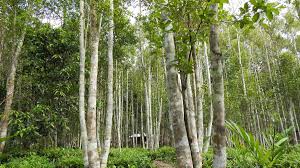The Hindu : Page 06
Syllabus : GS 3 : Environment and Ecology
India successfully prevented agarwood (Aquilaria malaccensis) from being included in CITES’ Review of Significant Trade (RST) and secured a new export quota starting April 2024.
- This benefits farmers in northeastern states, despite ongoing illegal trade issues.
- The Botanical Survey of India (BSI) and MoEFCC supported this move with a non-detriment findings (NDF) study.

Agarwood
- Agarwood (the Wood of Gods) also known as “Oud,” is a highly valuable and aromatic resinous wood produced by the Aquilaria tree.
- The resin forms in the heartwood of the tree when it becomes infected with a particular type of mold (Phialophora parasitica).
- This infection causes the tree to produce a dark, fragrant resin, which is highly sought after for its distinctive aroma.
- This contains essential oils with compounds like sesquiterpenes, chromones, and phenylethyl chromone derivatives.
- It thrives in tropical forests, at altitudes up to 1000 meters, often found in areas with high humidity and rainfall.
- Conservation Status:
o IUCN Status: Listed as Critically Endangered.
o CITES: Listed in Appendix II in 1995 based on India’s proposal at CoP9 in 1994.
Uses of Agarwood
- It is traditionally used as incense.
- Extracts (agarwood oil) are used in perfumes, the aroma industry, medicine, air fresheners, and purifiers.
- Essential oil has anti-inflammatory, anti-rheumatic, analgesic, and anti-oxidant properties.
CITES eases export of agarwood from India
- Inclusion of agarwood in the RST of CITES prevented
- India has successfully prevented inclusion of agarwood in the RST of the CITES.
- This development is going to benefit lakhs of farmers in certain districts of Assam, Manipur, Nagaland, and Tripura.
- Decision based on study by BSI
o India's removal from the RST for Aquilaria malaccensis was achieved through a study conducted by the Botanical Survey of India (BSI) under the MoEFCC.
o This study, known as a non-detriment finding (NDF), concluded that the species could be sustainably harvested under certain conditions.
o Key points from the NDF include:
- Restrictions: Harvesting plants, collecting seeds, seedlings, saplings, and other propagules should not be allowed from existing wild populations, protected areas, and reserve forests.
- Permitted Harvesting: Harvesting should be allowed from home and community gardens, plantations on leased or patta lands, private or community plantations, and other small-scale or large-scale plantations.
- Export Quotas: The NDF recommended an export quota for 2024–2027, allowing for 151,080 kg per year of agarwood chips and powder/sawdust and 7,050 kg per year of agarwood oil.
Significance for Farmers
- Agarwood cultivation is prevalent in parts of India, especially in the Northeast.
- This development will benefit lakhs of farmers in districts of Assam, Manipur, Nagaland, and Tripura.
CITES:
- CITES: Convention on International Trade in Endangered Species of Wild Fauna and Flora.
- Established: Signed in 1973 and entered into force in 1975.
- Objective: Ensure international trade does not threaten the survival of wild animals and plants.
- Parties: 184 countries.
- Appendices:
o Appendix I: Species threatened with extinction, trade permitted only in exceptional circumstances.
o Appendix II: Species not necessarily threatened with extinction, but trade must be controlled to avoid utilisation incompatible with their survival.
o Appendix III: Species protected in at least one country, which has asked other CITES Parties for assistance in controlling trade.
- Mechanism: Uses a system of permits and certificates to regulate trade.
- Impact: Significant in reducing illegal wildlife trade, aiding conservation efforts.
- Challenges: Enforcement issues, illicit trafficking, compliance gaps among member countries.
UPSC Prelims PYQ : 2016
Ques : With reference to ‘Red Sanders’, sometimes seen in the news, consider the following statements:
1. It is a tree species found in a part of South India.
2. It is one of the most important trees in the tropical rainforest areas of South India.
Which of the statements given above is /are correct?
(a) 1 only
(b) 2 only
(c) Both 1 and 2
(d) Neither 1 nor 2
Ans: (a)




